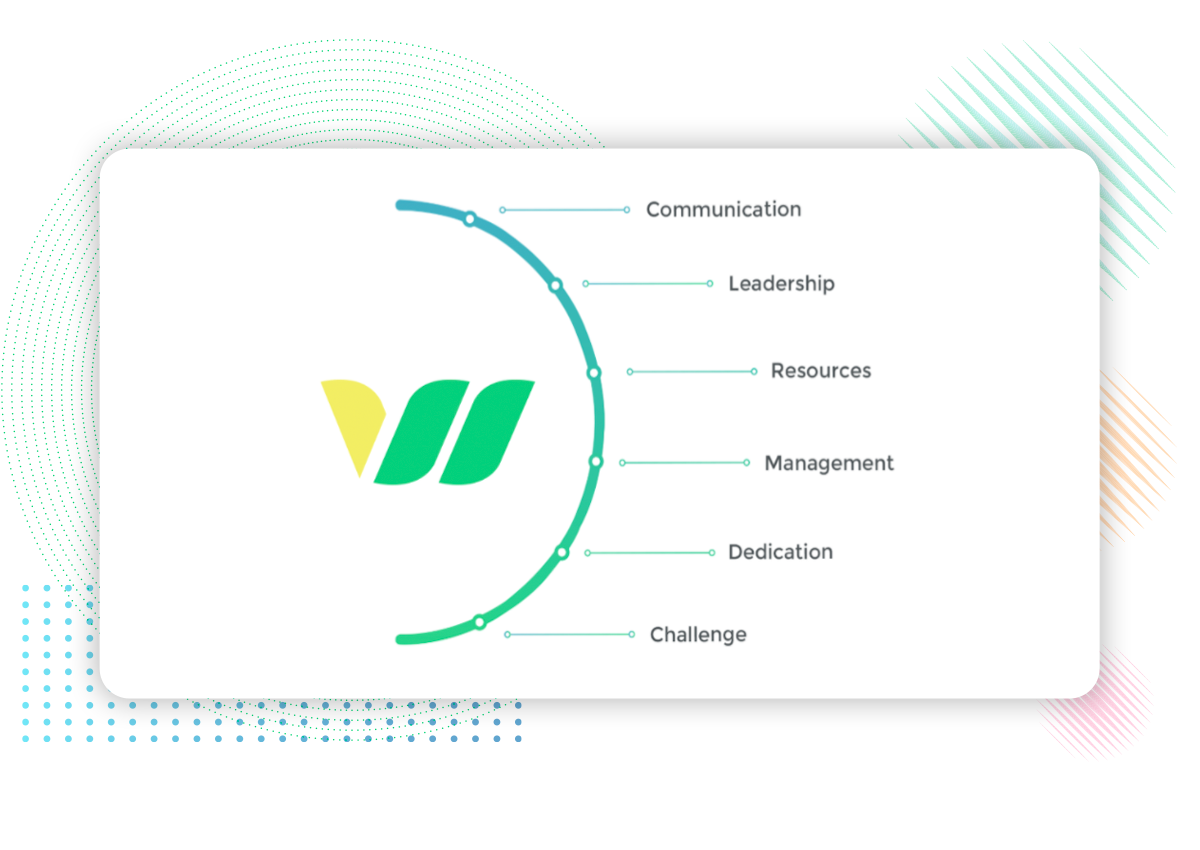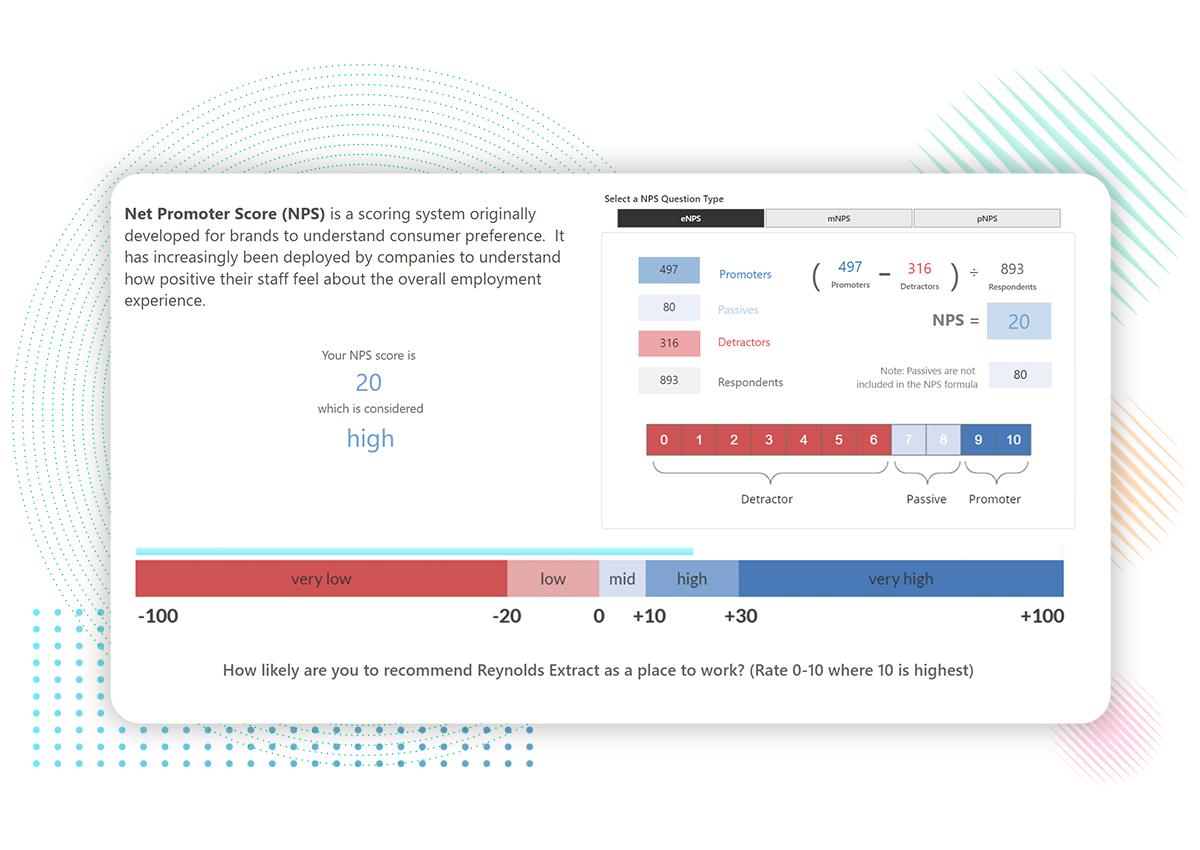December 1, 2023


Maximizing Employee Engagement with Pulse Survey Software
Employee engagement has been a top priority for companies for the past few years and continues to be one in 2024. It's no surprise why either - employee engagement is a critical indicator of productivity, efficiency, and the overall success of a company.
But knowing where to start improving employee engagement can be challenging. That's where pulse survey tools come in.
Pulse surveys help companies keep in touch with their employees and allows leaders to make changes based on employee feedback.
Here, we'll explore what employee pulse survey software is, why it's important, and key features to look for to ensure you get the best employee pulse survey tool for your needs.
What are Pulse Surveys?
Pulse surveys are a type of employee engagement surveys. Where engagement surveys tend to be longer and given less often, pulse surveys are short, frequent surveys designed to collect timely employee feedback.
Unlike traditional annual surveys, pulse surveys are conducted more regularly, often weekly, bi-weekly, or monthly.
The goal is to gather quick, focused insights on specific aspects of an organization, such as employee satisfaction, engagement, or customer feedback. The term "pulse" reflects the idea of taking the organization's "pulse" or checking its vital signs regularly.
Key Characteristics of Pulse Surveys:
Frequency:
Pulse survey frequency is typically more often than other employee engagement surveys. Pulse surveys are conducted on a regular and frequent basis. This allows organizations to stay informed about the evolving sentiments and concerns of their stakeholders.
Brevity:
Pulse surveys are typically shorter in length compared to traditional surveys. They are designed to be quick and easy to complete, encouraging higher participation rates.
Real-time Insights:
The short and regular nature of pulse surveys enables organizations to collect real-time data. This is especially valuable for monitoring changes in employee morale or customer satisfaction over short periods.
Specific Focus Areas:
Pulse surveys often focus on specific areas of interest, such as job satisfaction, team collaboration, or the effectiveness of recent organizational changes. This targeted approach allows organizations to address specific issues promptly.
Agility:
The agility of pulse surveys enables organizations to adapt quickly to emerging trends or challenges. If there is a sudden concern or a need for feedback on a specific initiative, pulse surveys can be deployed promptly.


Employee Engagement:
One of the primary use cases for pulse surveys is measuring and improving employee engagement. By regularly assessing employee satisfaction and identifying potential issues, organizations can take proactive steps to enhance the workplace environment.
RELATED: What is an Employee Engagement Survey? And Why Should You Care?
Feedback Loop:
Pulse surveys establish a continuous feedback loop between employees and management. This ongoing dialogue fosters a culture of transparency and responsiveness within the organization.
Technology-Driven:
Pulse surveys are often facilitated by survey software and other technology tools. These tools streamline the survey creation, distribution, and analysis processes.
Anonymity:
To encourage honest and open feedback, pulse surveys often allow respondents to remain anonymous. This can lead to more candid responses and a more accurate representation of sentiments.
Data-Driven Decision Making:
The data collected from pulse surveys can inform data-driven decision-making processes. Organizations can use the insights gained to make informed changes, address concerns, and enhance overall performance.
Pulse surveys provide organizations with a valuable tool for staying connected with the needs and perceptions of their stakeholders in a rapidly changing environment. By incorporating regular feedback mechanisms, organizations can adapt and respond to challenges more effectively.


10 Best Pulse Survey Software Providers
When selecting the best employee pulse survey tool for your company, consider factors like those listed above - ease of use, customization options, integration capabilities with an employee engagement platform, and the level of support provided by the software vendor.
But with so many providers on the market today, shopping around can still be overwhelming even when you know what to look for.
We've listed a range of employee survey tools to help you get started on your journey.
1. Terryberry
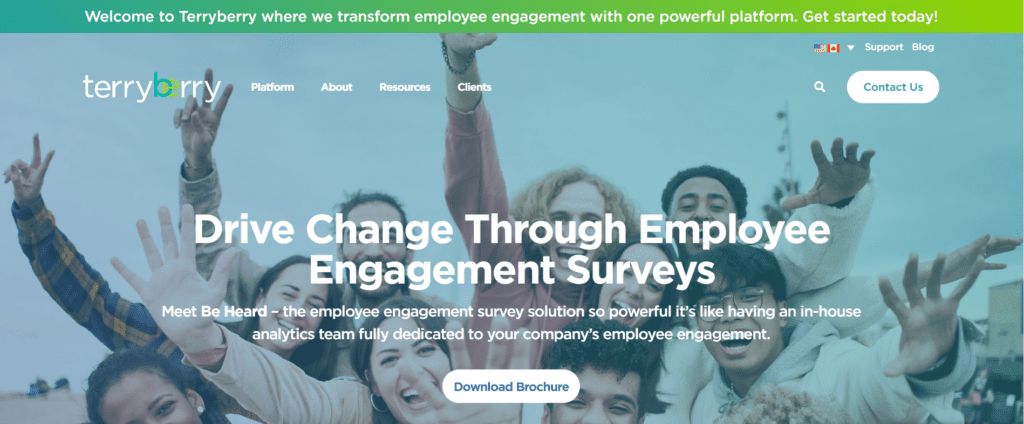
Terryberry's survey solution, Be Heard, delivers powerful information in a user-friendly platform. Utilize our intuitive drag-and-drop design capabilities without losing customization options. Plus, get actionable insights through easy-to-interpret visuals that help drive data-backed decisions.
Leave the guesswork behind and start making strategic decisions that lead to a more successful and sustainable business.
- Predict turnover likelihood by department, manager, and more so you can prevent voluntary turnover wherever possible.
- Track engagement with key predictors that indicate what motivate and demotivate employees.
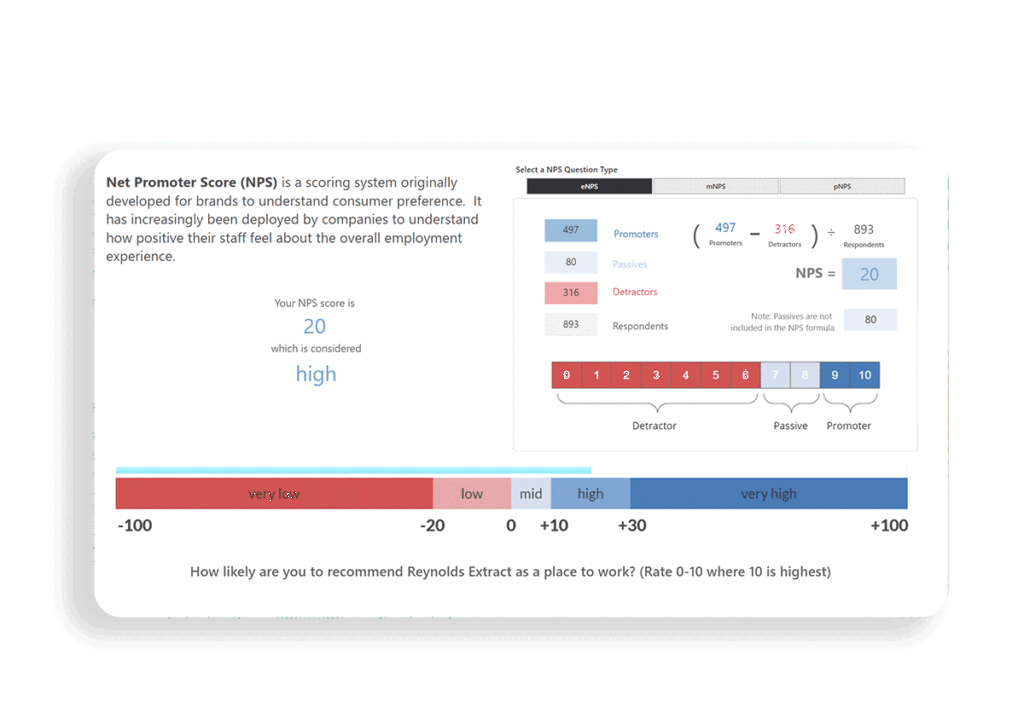

Stop Guessing and Discover Opportunity
Every great relationship is based on strong communication. The relationship you have with your employees should be no different. Rather than guessing how they feel – ask.
Using Terryberry's science-backed culture model, gather real employee intel to drive informed, meaningful changes that boost engagement, reduce turnover, and improve outcomes.
Best for: Teams of 250-10,000+
Key Features of Terryberry's Be Heard survey software:
- Pulse surveys and engagement surveys
- New hire, exit, and stay surveys
- Customizable surveys
- 360 Feedback
- Custom dashboards with actionable insights
- User-friendly interface
- Multichannel survey distribution (email, SMS, kiosk)
- Presentation-ready reporting
- Expert help with survey design
- One-on-one survey results walkthrough
- Security and compliance
- Integration capabilities
- Mobile optimization
Surveys | Recognition | Rewards | Wellness
Start small, dream big. Our customizable program lets you begin with the elements you need now, with the flexibility to add more as your engagement goals evolve.
Get all your employee engagement needs in one place with Terryberry - the only end-to-end employee engagement platform on the market today.
2. Google Forms
Google Forms is a free, web-based tool offered by Google that allows users to create forms, surveys, and quizzes easily.
Best for: Teams under 50
Key Features of Google Forms:
- Form Creation
- Survey and Quiz Functionality
- Theme Customization
- Various Question Types
- Free
Lowest-Rated Features by Users:
- File upload restrictions
- Limited Versatility
- Date picker lacks important features
- Lack of design customizations
- Lack of integrations
Learn more about Google Forms.
3. TINYpulse
TINYpulse is an employee feedback and engagement platform designed to help organizations measure and improve employee satisfaction and performance.
Best for: Teams of 50-1,000
Key Features of Tiny Pulse:
- Pulse Surveys
- Recognition and Cheers
- Anonymous Feedback
- Employee Engagement Surveys
- Feedback Channels
Lowest-Rated Features by Users:
- Confusing user interface
- Inflexible licensing options
- Overly complex
- Does not allow RSS feeds
Learn more about TINYpulse.
4. Geekbot
Geekbot is a tool designed to facilitate standup meetings, surveys, polls, and more. It provides a way for teams, especially those working remotely or following agile methodologies, to share progress, updates, and collaborate effectively.
Best for: Teams of 50-1,000
Key Features of Geekbot:
- Asynchronous Standup Meetings
- Slack Integration
- Customizable Standup Questions
- Scheduled Standup Reminders
- Multi-Time zone Support
Lowest-Rated Features by Users:
- Extensive delays
- Conflicting standups
- Limited to Slack and Teams
Learn more about Geekbot.


5. SurveyMonkey
SurveyMonkey is a versatile survey tool that can be used for pulse surveys. It's easy to use and provides a variety of survey question types.
Best for: Teams of 50-10,000+
Key Features of SurveyMonkey:
- Multichannel Survey Distribution
- Real-Time Analytics
- Mobile Optimization
- Advanced Question Types
- 360-Degree Feedback
Lowest-Rated Features by Users:
- Limited customization
- Basic data collection
- Limited free plan features and number of responses allowed
Learn more about SurveyMonkey.
6. Culture Monkey
CultureMonkey helps companies gather employee feedback, assess happiness levels, and implement strategic actions with web and mobile applications. Utilize employee engagement templates and gain insights to drive change.
Best for: Teams of 50-1,000
Key Features of Culture Monkey:
- Survey Management
- Collaboration Tools
- Onboarding
- Collaboration
- Feedback Management
Lowest-Rated Features by Users:
- Limited industry benchmarks
- Challenging navigation
- Loading issues
Learn more about Culture Monkey.
7. Microsoft Viva Glint
Microsoft Viva is a platform designed to enhance employee experiences and improve organizational productivity within Microsoft 365. Viva Glint, being a part of Viva, focuses on employee engagement and performance management.
Best for: Teams of 1,000-10,000+
Key Features of Glint:
- Employee Pulse Surveys
- Survey Customization
- Goal and Challenge Creation
- Employee Segmenting
- Goal and Challenge Creation
Lowest-Rated Features by Users:
- Clunky, complex interface
- Lacks customization
- Not as confidential as advertised
- Reporting is basic
Learn more about Microsoft Viva Glint.
8. Lattice
Lattice is an employee performance management platform that focuses on providing tools for continuous performance feedback, employee development, and goal setting.
Best for: Teams of 1,000-10,000+
Key Features of Lattice:
- Goal Setting and Tracking
- Performance Reviews
- 360-Degree Feedback
- Integration Capabilities
- Employee Engagement Surveys
Lowest-Rated Features by Users:
- Dashboards and reports
- Historical Data
- Customizable Forms
- Under-utilized, overly complex solutions
Learn more about Lattice.
9. Culture Amp
Culture Amp focuses on employee engagement and company culture. It provides surveys and analytics to help organizations understand and improve their workplace culture.
Best for: Teams of 1,000-10,000+
Key Features of Culture Amp:
- Employee Engagement Surveys
- Pulse Surveys
- Customizable Surveys
- Analytics and Reporting
- Actionable Insights
Lowest-Rated Features by Users:
- Not User Friendly
- User Interface
- Technical Issues
- Performance Issues
- Reporting Issues
- Under-utilized, overly complex solutions
Learn more about Culture Amp.
10. Qualtrics
Qualtrics is a comprehensive experience management platform that includes employee engagement surveys. It offers a range of survey types and powerful analytics.
Best for: Teams of >1,000-10,000+
Key Features of Qualtrics:
- Survey Creation and Design
- Multichannel Survey Distribution
- Real-Time Analytics
- Advanced Question Types
- Mobile Optimization
- 360-Degree Feedback
Lowest-Rated Features by Users:
- Usability is complicated
- Customer support is lacking
- Expensive for many companies
- Under-utilized, overly complex solutions
Learn more about Qualtrics.

What is Employee Survey Software?
As mentioned, pulse survey solutions are geared towards helping businesses and HR professionals gather real-time employee feedback through short and frequent surveys.
Pulse survey software refers to specialized tools and platforms designed to facilitate the creation, distribution, and analysis of pulse surveys within organizations.
This software is designed to improve employee engagement and streamline the survey process by making designing, distributing, and analyzing results simple.
Some pulse survey tools also integrate with an already-existing employee engagement platform. For example, Terryberry's employee survey platform, Be Heard, integrates with our employee recognition and corporate wellness platforms.
Why Use Employee Pulse Surveys
Employee engagement has arguably never been more important than it is today. So much so, research from Gallup found that nearly 85% of employees are either disengaged or actively disengaged at work.
With such a staggering number of disengaged employees, it's no wonder why more and more companies are turning to pulse survey tools to prioritize and improve employee engagement.
Employee pulse surveys provide a way to collect employee feedback and offer valuable insights into how team members feel about their work. When done right, surveys can help organizations improve communication, increase job satisfaction, and boost employee engagement.
Furthermore, companies with a highly engaged team are 21% more productive and 22% more profitable than a disengaged team.
With only 15% of the workforce feeling engaged, improving team morale and engagement should be a priority amongst all business leaders.
And one way to begin improving employee engagement is by listening to employee feedback given in employee pulse surveys.


Benefits of Pulse Surveys
Pulse surveys offer several benefits for organizations aiming to enhance employee engagement, gather feedback, and make data-driven decisions. Here are some key advantages of using a pulse survey tool:
Real-Time Feedback:
Immediate Insights: Pulse surveys provide quick and timely employee feedback, allowing organizations to stay informed about the current sentiments and concerns of employees.
Agility: The frequency of pulse surveys enables organizations to adapt swiftly to changes, emerging trends, or unforeseen challenges.
RELATED: 32 Pulse Survey Questions to Boost Employee Engagement
Improve Employee Engagement:
Continuous Dialogue: Regular pulse surveys foster a continuous dialogue between employees and management, promoting a culture of transparency and open communication.
Proactive Improvement: By regularly assessing employee engagement levels, organizations can proactively address issues that may impact morale and productivity.
Identifying Trends and Patterns:
Trend Analysis: Over time, pulse surveys help organizations identify trends and patterns in employee or customer feedback, allowing for a deeper understanding of underlying issues or successes.
Predictive Insights: By recognizing recurring themes, organizations can anticipate and address potential problems before they escalate.
Targeted Issue Resolution:
Specific Focus Areas: Pulse surveys often target specific areas of interest, such as job satisfaction, team collaboration, or the effectiveness of recent changes. This specificity allows organizations to address issues with precision.
Prioritization: The regular feedback from pulse surveys helps organizations prioritize issues based on their impact and urgency.
Employee Empowerment:
Voice Amplification: Pulse surveys give employees a platform to voice their opinions, concerns, and suggestions. This can empower employees by making them feel heard and valued.
Inclusivity: Inclusive decision-making is facilitated as employees from various levels and departments contribute to the feedback process.


Enhanced Organizational Agility:
Adaptability: Pulse surveys support organizational agility by providing insights that can guide adaptive strategies in response to changing market conditions or internal dynamics.
Quick Decision-Making: Real-time data allows leaders to make informed decisions more quickly, which is crucial in fast-paced environments.
Identify Areas for Improvement:
Iterative Approach: Pulse surveys align with a continuous improvement mindset, encouraging organizations to iteratively enhance policies, procedures, and workplace conditions.
Learning Organization: Regular feedback fosters a learning culture, where organizations actively seek to learn and improve based on ongoing experiences.
Retention and Recruitment:
Retention Insights: Understanding employee satisfaction and engagement levels through pulse surveys can inform retention strategies, helping organizations retain top talent.
Employer Branding: Positive feedback from employees can contribute to a positive employer brand, making the organization more attractive to potential recruits.
Data-Driven Decision Making:
Informed Choices: The data collected from pulse surveys enables organizations to make informed, evidence-based decisions.
Performance Measurement: Key performance indicators derived from survey data contribute to the measurement of organizational effectiveness.
Flexibility and Adaptation:
Scalability: Pulse surveys are scalable, making them suitable for organizations of various sizes.
Adaptable to Remote Work: In a remote or hybrid work environment, pulse surveys help organizations stay connected with dispersed teams and understand their unique challenges and needs.
By leveraging employee pulse survey tools, organizations can gain a deeper understanding of their workforce, enhance employee satisfaction, and create a more agile and responsive workplace culture.


Key features of employee pulse survey software:
Understanding the importance of pulse survey tools is one thing, but knowing which one is right for your needs can be a different story entirely.
To help you navigate the many employee pulse survey tools on the market today, we've listed out some key features of the best pulse survey tools to help you get the right one for your needs.
Survey Creation Tools
To start, you'll likely want easy-to-create, yet customizable surveys. This means, your employee pulse survey tools should support:
- User-friendly interfaces for designing surveys.
- Customizable question templates.
- Options for incorporating different question types.
Frequency and Scheduling
Being able to schedule surveys is another great feature. This way you won't have to reply on setting reminders manually for your different survey types. Look for:
- Ability to set up recurring surveys at predetermined intervals (e.g., weekly, monthly).
- Scheduling features for automated survey distribution.


Analysis and Reporting
It's also important to be able to easily interpret your survey results. This means receiving actionable insights from your pulse survey tool. Look for:
- Tools for analyzing survey results.
- Data visualization features for clear and comprehensive reporting.
Real-Time Feedback
Surveys aren't helpful unless you can analyze and interpret survey data in real-time. This gives you the ability to respond to issues quickly and efficiently. Look for:
- Capability to collect and analyze real-time feedback.
- Immediate reporting and dashboard features for quick insights.
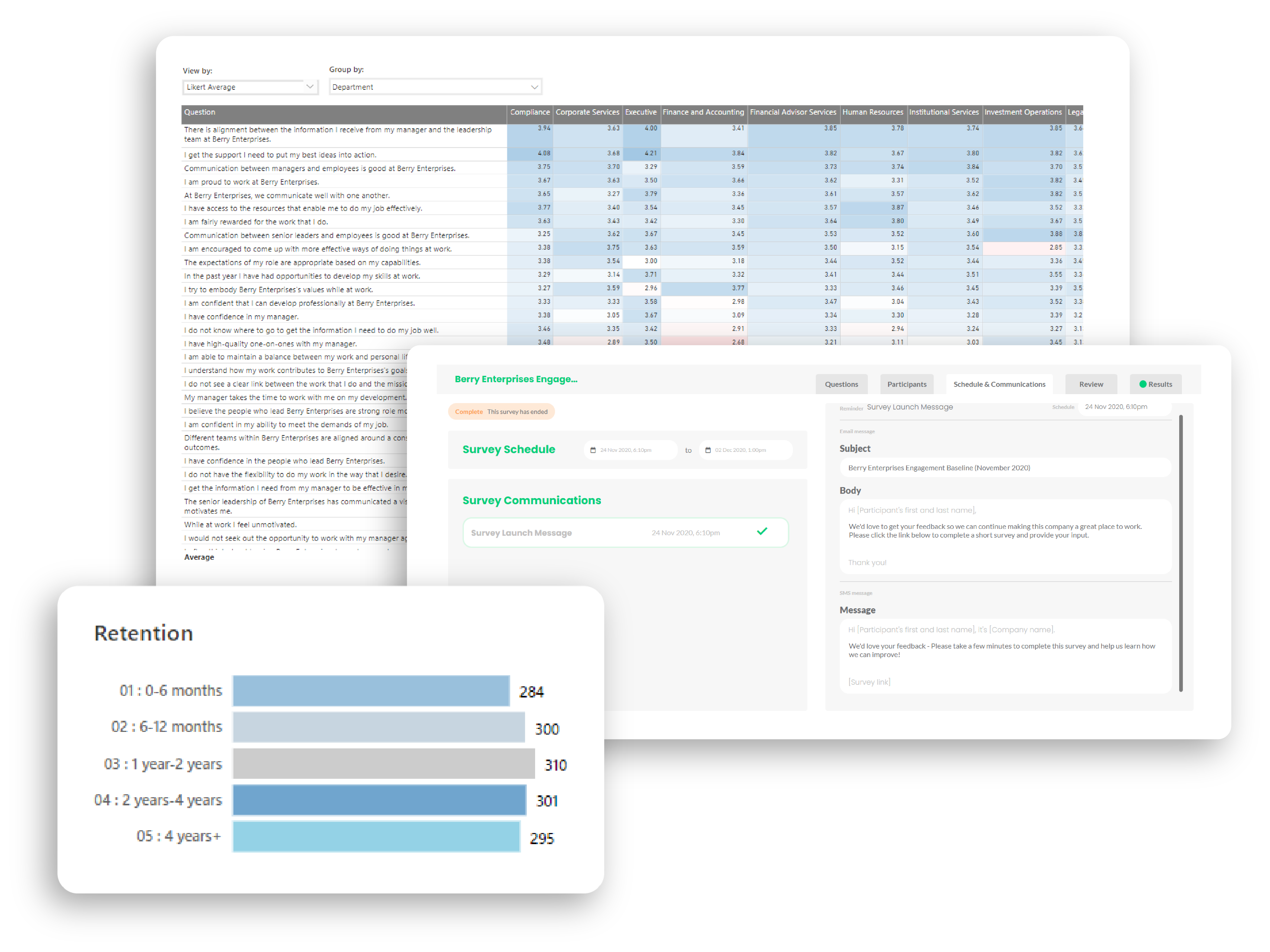

Customization Options
Being able to create customized surveys is important for ensuring you're tracking and measuring what's relevant to your company. Depending on your needs, you may want to measure employee engagement but have no need to track DEI initiatives.
- Flexibility to tailor surveys to specific topics or organizational needs.
- Branding options to align with the organization's identity.
Anonymity and Confidentiality
It's critical that your survey solution has the option to administer anonymous employee pulse surveys. The best pulse survey responses come from employees feeling safe to speak their mind freely, without fear of backlash. So, be sure to look for:
- Options for respondents to provide anonymous feedback.
- Assurance of data confidentiality and security.
Integration
Another great feature in pulse survey tools is integrations with other platforms you may be using, like an employee engagement platform or HRIS. Keep an eye out for:
- Integration capabilities with other organizational tools and systems, such as HR software or collaboration platforms.
- Data synchronization to ensure a seamless flow of information.
Action Planning Support
Depending on your expertise level, you may opt for a pulse survey tool that offers action planning support. This means going a step beyond the software's built-in analytics and receiving actionable insights from the pulse survey provider.
- Features to assist organizations in developing action plans based on survey findings.
- Collaboration tools to involve teams in addressing identified issues.
Pulse Survey Questions
Once you've chosen the right employee pulse survey tool for your company, the next step is to start designing your survey questions.
Remember to keep pulse survey questions concise, focused, and relevant to the specific goals you want to achieve with the survey.
Also, consider using a mix of open-ended and multiple-choice questions to gather both quantitative and qualitative data in your employee surveys.
Below are some example pulse survey questions to get you started.
Pulse Survey Questions About Overall Job Satisfaction:
On a scale of 1 to 10, how satisfied are you with your job?
How much do you enjoy the tasks and responsibilities of your job?
How satisfied are you with your relationships with colleagues?
Do you feel recognized and appreciated for your contributions at work?
How satisfied are you with your current work-life balance?


Pulse Survey Questions About Company Culture
Do you feel that communication within the company is transparent and effective?
How inclusive do you find the company culture in terms of diversity and respect for different perspectives?
Do you think the company prioritizes employee well-being?
Do you feel a strong sense of belonging to the company and its mission?
How collaborative is the culture within your team or department?
RELATED: 83 Employee Survey Questions About Culture to Use in Your Next Employee Survey


Pulse Survey Questions About Leadership
To what extent do you feel supported by your immediate supervisor or manager?
How would you describe the leadership style within the company?
On a scale of 1 to 5, how effective do you think the leadership team is in guiding the company?
How satisfied are you with the communication from the leadership team regarding company goals and strategy?
Do you feel that leaders are accessible and approachable when needed?


Pulse Survey Questions About Professional Development
Do you feel there are opportunities for career growth and development in your current role?
How supportive is the company culture in terms of learning and professional development?
How supportive is the leadership team in terms of your professional development and career growth?
How satisfied are you with the opportunities provided for developing new skills in your current role?
How satisfied are you with the training and learning opportunities provided by the company?


Pulse Survey Questions About DEI
On a scale of 1 to 5, how included do you feel the workplace culture is in terms of diversity, equity, and inclusion?
How aware are you of the efforts made by the company to promote diversity in the workplace?
To what extent do you believe that leaders within the organization promote an inclusive and equitable environment?
How confident are you that everyone in the organization has equal opportunities for career advancement and success?
How satisfied are you with the representation of diverse perspectives at different levels within the organization?
RELATED: 32 Pulse Survey Questions to Boost Employee Engagement
Utilizing Pulse Survey Feedback
Once you've collected your survey results, it's time now to take action on the employee feedback. This stage is arguably the most critical part of your engagement strategy.
Doing so shows your team that their voices are being heard. Not only will this build trust, it will also encourage employees to take part in future surveys as well.
Conversely, without taking action, you'll risk employees experiencing survey fatigue - feeling that giving an opinion is pointless so employees begin to stop participating in surveys. Inaction can also cause employees to start to view leadership as hypocritical.
So, whether you decide to address concerns directly with employees or make changes to company policy, it's crucial that you address employee feedback in one form or another.
Start Building an Employee Pulse Survey Strategy Today
Employee survey tools can be a great way to help organizations gain valuable insights that ultimately lead to a more resilient workforce. By asking the right questions and taking action on the results, companies can creative highly engaged employees.
Terryberry provides solutions to help drive employee satisfaction through our effective employee engagement and pulse surveys solution:
Pulse Survey Software: Be Heard is an employee engagement survey solution that's designed to enhance your employee experience while fueling business performance.
Ready to learn more? Schedule a demo with our team to get a hands-on walkthrough of how Terryberry can transform the culture of your workplace.


